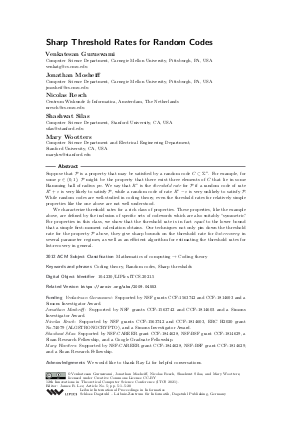Sharp Threshold Rates for Random Codes
Authors Venkatesan Guruswami, Jonathan Mosheiff, Nicolas Resch, Shashwat Silas, Mary Wootters
-
Part of:
Volume:
12th Innovations in Theoretical Computer Science Conference (ITCS 2021)
Part of: Series: Leibniz International Proceedings in Informatics (LIPIcs)
Part of: Conference: Innovations in Theoretical Computer Science Conference (ITCS) - License:
 Creative Commons Attribution 3.0 Unported license
Creative Commons Attribution 3.0 Unported license
- Publication Date: 2021-02-04
File

PDF
LIPIcs.ITCS.2021.5.pdf
- Filesize: 0.53 MB
- 20 pages
Document Identifiers
Related Versions
Subject Classification
ACM Subject Classification
- Mathematics of computing → Coding theory
Keywords
- Coding theory
- Random codes
- Sharp thresholds
Metrics
- Access Statistics
-
Total Accesses (updated on a weekly basis)
0PDF Downloads0Metadata Views
Abstract
Suppose that 𝒫 is a property that may be satisfied by a random code C ⊂ Σⁿ. For example, for some p ∈ (0,1), 𝒫 might be the property that there exist three elements of C that lie in some Hamming ball of radius pn. We say that R^* is the threshold rate for 𝒫 if a random code of rate R^* + ε is very likely to satisfy 𝒫, while a random code of rate R^* - ε is very unlikely to satisfy 𝒫. While random codes are well-studied in coding theory, even the threshold rates for relatively simple properties like the one above are not well understood. We characterize threshold rates for a rich class of properties. These properties, like the example above, are defined by the inclusion of specific sets of codewords which are also suitably "symmetric." For properties in this class, we show that the threshold rate is in fact equal to the lower bound that a simple first-moment calculation obtains. Our techniques not only pin down the threshold rate for the property 𝒫 above, they give sharp bounds on the threshold rate for list-recovery in several parameter regimes, as well as an efficient algorithm for estimating the threshold rates for list-recovery in general.
Cite As Get BibTex
Venkatesan Guruswami, Jonathan Mosheiff, Nicolas Resch, Shashwat Silas, and Mary Wootters. Sharp Threshold Rates for Random Codes. In 12th Innovations in Theoretical Computer Science Conference (ITCS 2021). Leibniz International Proceedings in Informatics (LIPIcs), Volume 185, pp. 5:1-5:20, Schloss Dagstuhl – Leibniz-Zentrum für Informatik (2021)
https://doi.org/10.4230/LIPIcs.ITCS.2021.5
BibTex
@InProceedings{guruswami_et_al:LIPIcs.ITCS.2021.5,
author = {Guruswami, Venkatesan and Mosheiff, Jonathan and Resch, Nicolas and Silas, Shashwat and Wootters, Mary},
title = {{Sharp Threshold Rates for Random Codes}},
booktitle = {12th Innovations in Theoretical Computer Science Conference (ITCS 2021)},
pages = {5:1--5:20},
series = {Leibniz International Proceedings in Informatics (LIPIcs)},
ISBN = {978-3-95977-177-1},
ISSN = {1868-8969},
year = {2021},
volume = {185},
editor = {Lee, James R.},
publisher = {Schloss Dagstuhl -- Leibniz-Zentrum f{\"u}r Informatik},
address = {Dagstuhl, Germany},
URL = {https://drops.dagstuhl.de/entities/document/10.4230/LIPIcs.ITCS.2021.5},
URN = {urn:nbn:de:0030-drops-135446},
doi = {10.4230/LIPIcs.ITCS.2021.5},
annote = {Keywords: Coding theory, Random codes, Sharp thresholds}
}
Author Details
Funding
- Guruswami, Venkatesan: Supported by NSF grants CCF-1563742 and CCF-1814603 and a Simons Investigator Award.
- Mosheiff, Jonathan: Supported by NSF grants CCF-1563742 and CCF-1814603 and a Simons Investigator Award.
- Resch, Nicolas: Supported by NSF grants CCF-1563742 and CCF-1814603, ERC H2020 grant No.74079 (ALGSTRONGCRYPTO), and a Simons Investigator Award.
- Silas, Shashwat: Supported by NSF-CAREER grant CCF-1844628, NSF-BSF grant CCF-1814629, a Sloan Research Fellowship, and a Google Graduate Fellowship.
- Wootters, Mary: Supported by NSF-CAREER grant CCF-1844628, NSF-BSF grant CCF-1814629, and a Sloan Research Fellowship.
Acknowledgements
We would like to thank Ray Li for helpful conversations.
References
- Béla Bollobás. Random Graphs, Second Edition, volume 73 of Cambridge Studies in Advanced Mathematics. Cambridge University Press, 2001. URL: https://doi.org/10.1017/CBO9780511814068.
-
Imre Csiszár and Paul C Shields. Information theory and statistics: A tutorial. Now Publishers Inc, 2004.

-
P. Erdős and A. Rényi. On random graphs. I. Publ. Math. Debrecen, 6:290-297, 1959.

- Keith Frankston, Jeff Kahn, Bhargav Narayanan, and Jinyoung Park. Thresholds versus fractional expectation-thresholds. arXiv preprint, 2019. URL: http://arxiv.org/abs/1910.13433.
-
Michael L Fredman and János Komlós. On the size of separating systems and families of perfect hash functions. SIAM Journal on Algebraic Discrete Methods, 5(1):61-68, 1984.

- Ehud Friedgut. Sharp thresholds of graph properties, and the k-sat problem. J. Amer. Math. Soc., 12(4):1017-1054, 1999. With an appendix by Jean Bourgain. URL: https://doi.org/10.1090/S0894-0347-99-00305-7.
- Venkatesan Guruswami, Johan Håstad, and Swastik Kopparty. On the list-decodability of random linear codes. IEEE Trans. Information Theory, 57(2):718-725, 2011. URL: https://doi.org/10.1109/TIT.2010.2095170.
- Venkatesan Guruswami, Ray Li, Jonathan Mosheiff, Nicolas Resch, Shashwat Silas, and Mary Wootters. Bounds for list-decoding and list-recovery of random linear codes. arXiv preprint, 2020. URL: http://arxiv.org/abs/2004.13247.
-
Venkatesan Guruswami and Andrii Riazanov. Beating fredman-komlós for perfect k-hashing. In 46th International Colloquium on Automata, Languages, and Programming (ICALP 2019). Schloss Dagstuhl-Leibniz-Zentrum fuer Informatik, 2019.

-
Venkatesan Guruswami, Christopher Umans, and Salil Vadhan. Unbalanced expanders and randomness extractors from parvaresh-vardy codes. Journal of the ACM (JACM), 56(4):1-34, 2009.

-
J Korner and Katalin Marton. New bounds for perfect hashing via information theory. European Journal of Combinatorics, 9(6):523-530, 1988.

-
Jénos Körner. Fredman-komlós bounds and information theory. SIAM Journal on Algebraic Discrete Methods, 7(4):560-570, 1986.

- Jonathan Mosheiff, Nicolas Resch, Noga Ron-Zewi, Shashwat Silas, and Mary Wootters. Ldpc codes achieve list decoding capacity. arXiv preprint, 2019. URL: http://arxiv.org/abs/1909.06430.
-
Nicolas Resch. List-Decodable Codes:(Randomized) Constructions and Applications. PhD thesis, Carnegie Mellon University, 2020.

-
Atri Rudra and Mary Wootters. Average-radius list-recovery of random linear codes. In Proceedings of the 2018 ACM-SIAM Symposium on Discrete Algorithms, SODA, 2018.

- Salil P. Vadhan. Pseudorandomness. Foundations and Trends in Theoretical Computer Science, 7(1-3):1-336, 2012. URL: https://doi.org/10.1561/0400000010.
- Martin J. Wainwright and Michael I. Jordan. Graphical models, exponential families, and variational inference. Foundations and Trends in Machine Learning, 1(1-2):1-305, 2008. URL: https://doi.org/10.1561/2200000001.
- Chaoping Xing and Chen Yuan. Beating the probabilistic lower bound on perfect hashing. arXiv preprint, 2019. URL: http://arxiv.org/abs/1908.08792.
-
Victor Vasilievich Zyablov and Mark Semenovich Pinsker. List concatenated decoding. Problemy Peredachi Informatsii, 17(4):29-33, 1981.

